The mute swan, with its graceful presence and distinctive behaviors, captivates both nature enthusiasts and casual observers. While the male and female mute swans share many traits, there exist subtle differentiators that set them apart.
From the striking forehead knob of the male to the nurturing maternal care provided by the female, these distinctions add depth to the understanding of this iconic species.
Exploring features such as plumage color variations, territorial behaviors, and even the coloration of their cygnets offers insights into the intricate dynamics that shape the lives of these elegant waterfowl.
Delving into these details allows us to appreciate the complexity that underlies their serene beauty.
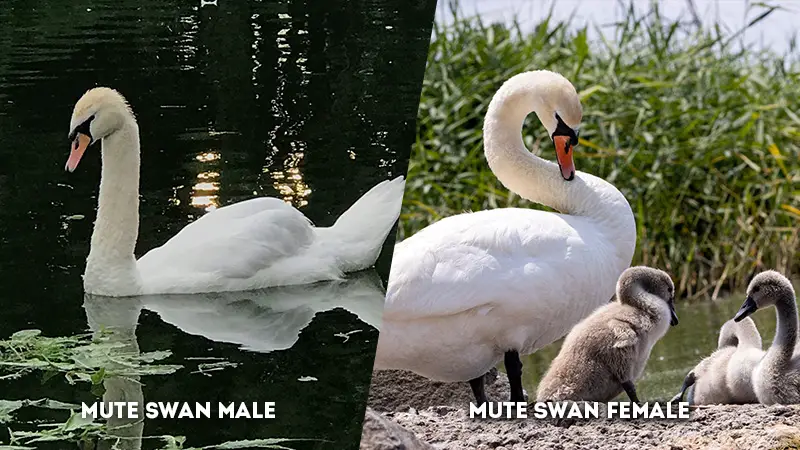
Key Differences Between Male and Female Mute Swans
Size
- Male Mute Swan: Males of the mute swan species are notably larger and heavier compared to their female counterparts.
This size disparity becomes more evident as they mature. Their increased size gives them a bulkier appearance, particularly in terms of body mass and overall dimensions. - Female Mute Swan: Female mute swans, in contrast, are smaller and lighter than males. Their size tends to be more compact and streamlined compared to the larger, more robust males.
This difference in size is a common characteristic among male and female mute swans, and it plays a role in various aspects of their behavior and reproductive roles.
Forehead Knob
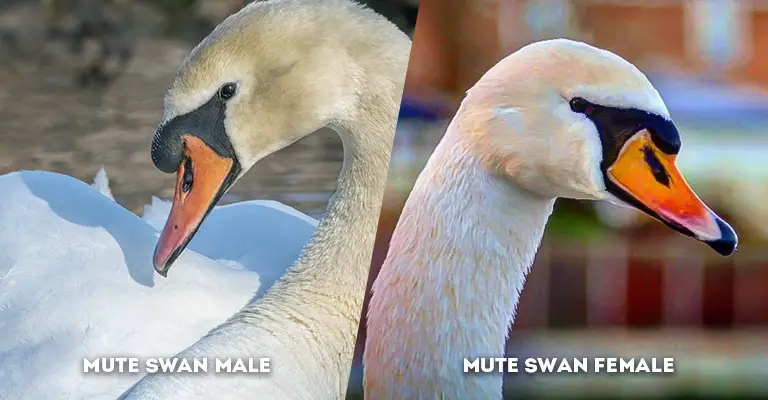
- Male Mute Swan: One of the most distinguishing features between male and female mute swans is the presence of a forehead knob in males.
This knob, located at the base of the bill between the eyes, is a fleshy protuberance that is absent in females. The knob’s size and prominence tend to increase with age and maturity. - Female Mute Swan: Female mute swans lack the characteristic forehead knob that is present in their male counterparts. Instead, their heads have a smoother and more streamlined appearance.
The absence of the knob does not diminish their significance within the swan community; females play vital roles in nesting, incubation, and raising cygnets.
Neck Length
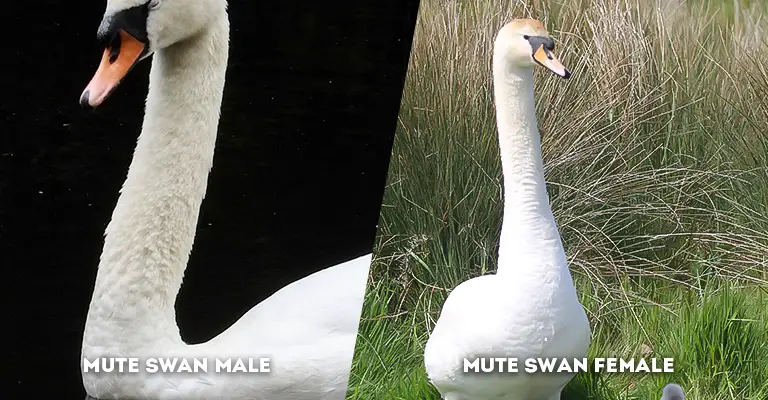
- Male Mute Swan: Male mute swans typically have slightly longer necks compared to females. This elongation is more noticeable during certain postures, such as when the swan is swimming gracefully or engaging in courtship displays.
The longer neck is both an aesthetic and functional feature, contributing to their elegant and majestic appearance. - Female Mute Swan: Female mute swans have necks that are slightly shorter in comparison to males. While this distinction might not be as immediately noticeable, it does contribute to their more compact and streamlined appearance.
The slightly shorter neck aligns with the female’s roles in nesting and incubation, allowing her to tend to her eggs with efficiency.
Breeding Behavior
- Male Mute Swan: Breeding behavior in male mute swans is marked by increased aggressiveness and territoriality.
During the breeding season, males vigorously defend their chosen territory, often displaying dominance over other males through confrontations and displays of strength. Their goal is to establish a safe space for their mate and offspring. - Female Mute Swan: Female mute swans exhibit less aggressive behavior during the breeding season. Their primary focus is on nest building, incubating eggs, and eventually raising cygnets.
While they might not engage in territorial battles like males, they contribute significantly to the reproductive success of the pair.
Voice
- Male Mute Swan: Male mute swans possess slightly different vocalizations compared to females. Their calls are often deeper and more resonant, carrying over long distances. These vocalizations play a role in communication, especially during territorial disputes and courtship displays.
- Female Mute Swan: Female mute swans have vocalizations that are distinct from males but generally less resonant. Their calls are typically softer and might serve various purposes, including communication within the pair and between adults and cygnets.
Plumage Color (Breeding)
- Male Mute Swan: During the breeding season, male mute swans exhibit slightly brighter and cleaner plumage compared to females. This is due to hormonal changes that affect the coloration of their feathers.
The white plumage of the males appears to have a more radiant and polished appearance, which can enhance their visual appeal during courtship displays and interactions with potential mates. - Female Mute Swan: Female mute swans, while also displaying white plumage during the breeding season, tend to have a subtly different hue compared to the males.
Their plumage might appear slightly softer or less brilliantly white due to hormonal variations. This difference, although nuanced, helps individuals identify males and females when observing them closely.
Plumage Color (Non-breeding)
- Male Mute Swan: In the non-breeding season, the plumage color of male mute swans remains relatively consistent. The white feathers continue to exude a sense of elegance and grace, making them easy to recognize even from a distance.
The slight differences in hue between breeding and non-breeding plumage persist, although they might be less pronounced. - Female Mute Swan: Similar to males, female mute swans also maintain their white plumage during the non-breeding season.
The subtle variations in coloration that were present during breeding persist, and their feathers continue to contribute to their overall ethereal appearance.
This consistent white plumage allows individuals to identify mute swans as a distinct species throughout the year.
Bill Size
- Male Mute Swan: Male mute swans typically have slightly larger bills compared to females. This size difference might not be immediately noticeable from a distance, but upon closer observation, the bill of a male swan appears more robust.
The larger bill could be attributed to their more territorial and protective behavior during the breeding season, requiring additional physical prowess. - Female Mute Swan: Female mute swans possess bills that are slightly smaller in comparison to males. This size difference aligns with their roles as caregivers and nest builders.
The smaller bill size allows them to engage in intricate tasks, such as gathering nesting materials and tending to their young, with greater precision.
Body Shape
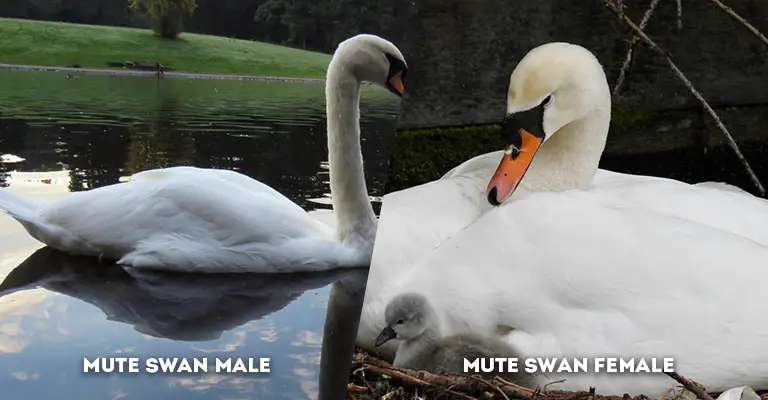
- Male Mute Swan: The body shape of male mute swans tends to be bulkier and more robust. This is particularly evident in their chest and overall body mass. The larger body size and shape play a role in their territorial behavior, as well as their ability to engage in displays of strength during the breeding season.
- Female Mute Swan: Female mute swans exhibit a more streamlined and slightly slimmer body shape compared to males. This body structure aids in their roles as nest builders and caregivers.
The streamlined shape enables them to move through water with agility, facilitating their tasks of incubating eggs and safeguarding their cygnets.
Behavior Around Cygnets
- Male Mute Swan: Male mute swans can exhibit protective behaviors around cygnets, especially during the vulnerable early stages of their lives.
While males are generally known for their territorial displays, they can also play a role in defending their offspring against potential threats. Their larger size and occasional aggressiveness serve as deterrents to potential predators. - Female Mute Swan: Female mute swans are actively involved in the care of their cygnets. They often take the lead in incubating the eggs and providing immediate care for the newly hatched cygnets.
Females display a nurturing behavior, guiding their young and ensuring their safety in various aquatic environments.
Nest Building
- Male Mute Swan: Nest building is primarily the responsibility of the female mute swan. However, males play a supportive role by assisting in gathering nesting materials.
They contribute by bringing vegetation and other necessary materials to the female, who then arranges them to construct the nest. This cooperative effort ensures a secure and well-prepared nesting site for the upcoming brood. - Female Mute Swan: Female mute swans take the lead in nest building. They meticulously gather and arrange various materials, such as reeds, twigs, and aquatic plants, to construct a sturdy and well-insulated nest.
The female’s attention to detail in nest building contributes to the overall success of incubation and ensures a suitable environment for the cygnets’ development.
Courtship Display
- Male Mute Swan: Male mute swans engage in elaborate courtship displays during the breeding season to attract potential mates.
These displays include synchronized swimming, head bobbing, and intricate movements that showcase their strength and agility. The male’s goal is to impress and convince a female to choose him as a partner. - Female Mute Swan: Female mute swans observe and evaluate the courtship displays of male suitors.
The elaborate displays provide valuable information about the male’s physical fitness and suitability as a mate. The female’s choice is influenced by the male’s ability to perform these displays and the overall impression he creates.
Territorial Behavior
- Male Mute Swan: Males exhibit more pronounced territorial behavior, particularly during the breeding season.
They vigorously defend their chosen territory from other males to ensure a safe space for their mate and future cygnets. Territorial displays might involve aggressive postures, vocalizations, and confrontations with intruding swans. - Female Mute Swan: Females also engage in territorial behavior but to a lesser extent. Their focus shifts more towards nesting and incubation, leading them to engage in fewer territorial disputes.
However, they are still involved in maintaining the defended territory and protecting their nesting site.
Swimming Patterns
- Male Mute Swan: Male mute swans often display dominance when swimming in groups. Their larger size and more assertive behavior allow them to assume a leadership role within their social circle.
This dominance might manifest through leading the group in synchronized swimming patterns and directing the movement of others. - Female Mute Swan: Females are also active participants in swimming groups, but their role is often less dominant. They contribute to the coordinated swimming patterns and follow the lead of the males.
Females’ participation in swimming groups supports social cohesion and communication among individuals within the group.
Head Shape
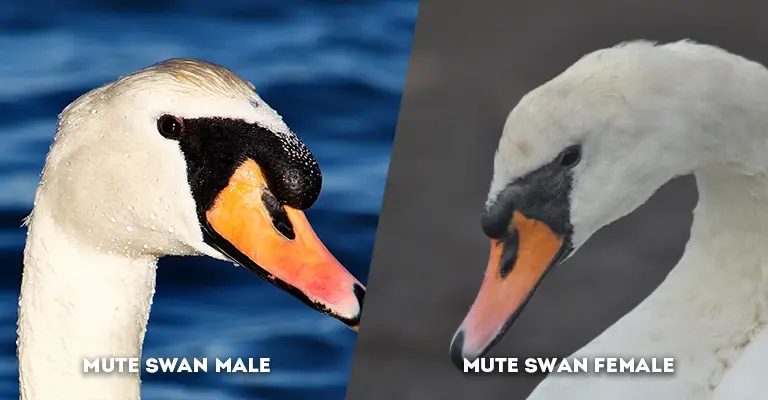
- Male Mute Swan: Male mute swans exhibit a more prominent curve in their head shape, particularly in the neck region. This slight curvature is often more noticeable during certain behaviors, such as when they are engaged in courtship displays or defensive postures. The curvature adds to the male’s distinctive appearance.
- Female Mute Swan: Female mute swans have a more subtle head shape with a straighter neck in comparison to males. This head shape allows them to maintain an efficient posture during activities like nest building, incubation, and caring for cygnets. The straighter neck aligns with their roles as nurturing caregivers.
Overall Aggressiveness
- Male Mute Swan: Male mute swans can exhibit a higher level of overall aggressiveness, particularly during the breeding season. This aggression is often directed towards rival males and potential threats to their territory and mate.
Their larger size and assertive behaviors, such as hissing and charging, play a role in establishing dominance and defending their interests. - Female Mute Swan: Females tend to display a lower level of overall aggressiveness compared to males. Their focus is primarily on maternal care and nesting activities.
While they might show defensive behaviors, they generally exhibit less aggressive confrontations with other swans.
Maternal Care
- Male Mute Swan: Male mute swans have limited involvement in maternal care. Their primary roles include assisting in nest building and defending the territory.
Once the cygnets hatch, their level of care is generally reduced, as the female takes on the responsibility of nurturing and protecting the young. - Female Mute Swan: Female mute swans play a crucial role in maternal care. They are actively involved in incubating the eggs, maintaining the nest, and caring for the cygnets after hatching.
Females are protective and nurturing, guiding their young in the water, teaching them to feed, and ensuring their safety.
Feather Brightness
- Male Mute Swan: Male mute swans exhibit slightly brighter and cleaner feather plumage, particularly during the breeding season.
This enhanced brightness is a result of hormonal changes that affect the coloration of their feathers. The increased brightness contributes to their attractiveness during courtship displays. - Female Mute Swan: Female mute swans also possess white feather plumage, but it might appear slightly softer or less brilliant compared to males.
The hormonal fluctuations during the breeding season influence the hue of their feathers. This nuanced difference aids in distinguishing between the sexes.
Feather Patterns

- Male Mute Swan: Male mute swans generally have similar feather patterns to females. Their plumage consists of a consistent white coloration.
The focus on differences between males and females primarily lies in size, behavior, and specific features such as the forehead knob. - Female Mute Swan: Female mute swans share feather patterns with males, maintaining a consistent white plumage.
The distinction between the sexes is not visually apparent through feather patterns alone, highlighting the importance of observing other characteristics.
Mute Swan Male Vs Female: Comparison Table
| Characteristic | Male Mute Swan | Female Mute Swan |
|---|---|---|
| Size | Larger and heavier | Smaller and lighter |
| Forehead Knob | Prominent knob present | No knob |
| Neck Length | Slightly longer | Slightly shorter |
| Breeding Behavior | More aggressive | Less aggressive |
| Voice | Slightly different vocalizations | Similar vocalizations |
| Plumage Color (Breeding) | Brighter, cleaner | Similar coloration |
| Plumage Color (Non-breeding) | Similar coloration | Similar coloration |
| Bill Size | Slightly larger | Slightly smaller |
| Body Shape | Bulkier body | Slightly slimmer body |
| Behavior Around Cygnets | Can be protective | Can be protective |
| Nest Building | Helps gather materials | Helps gather materials |
| Courtship Display | More elaborate displays | Less elaborate displays |
| Territorial Behavior | More territorial | Less territorial |
| Swimming Patterns | Dominant in swimming groups | Found in swimming groups |
| Head Shape | More pronounced curve | Subtle curve |
| Overall Aggressiveness | Can be more aggressive | Generally less aggressive |
| Maternal Care | Limited involvement | Mainly responsible for care |
| Feather Brightness | Slightly brighter | Slightly less bright |
| Feather Patterns | Similar feather patterns | Similar feather patterns |
| Cygnet Coloration | Usually white, some gray | Usually white, some gray |
Frequently Asked Questions
No, behavioral differences between male and female mute swan cygnets are generally not observed. Behavioral distinctions typically become more pronounced as they mature into adults.
Yes, gray-colored mute swan cygnets often transition to the more common white coloration as they mature. The gray color is often more prominent when they are very young, and their feathers gradually turn white as they age.
Mute swan cygnets with gray coloration might be at a slight disadvantage in terms of camouflage, especially if they are born in an environment where white feathers provide better concealment. However, this disadvantage tends to be minimized as they grow and develop more white feathers.
Genetic factors play a role in determining the coloration of mute swan cygnets. If both parents carry genetic traits for gray coloration, there’s a higher likelihood of producing gray cygnets. However, even with gray parents, some cygnets might still exhibit white coloration due to the complexity of genetic inheritance.
While genetic factors primarily determine coloration, environmental conditions can have a slight impact.
Factors like nutrition and habitat quality might influence the overall health of cygnets, potentially affecting the intensity of their coloration. However, genetic predisposition remains the primary factor in determining whether cygnets are gray or white.
To Recap
In the delicate balance of nature, the nuanced differences between male and female mute swans contribute to their collective survival and flourishing.
From the intricacies of plumage to the intricacies of behaviors, each distinction serves a purpose in the grand tapestry of their existence.
By delving into these distinctions, we gain a deeper appreciation for the roles each sex plays in the swan community, from courtship to nurturing the next generation.
Mute swans, with their elegance and enigmatic characteristics, remind us of the marvels that can be found in even the subtlest details of the natural world, enriching our connection to the beauty that surrounds us.